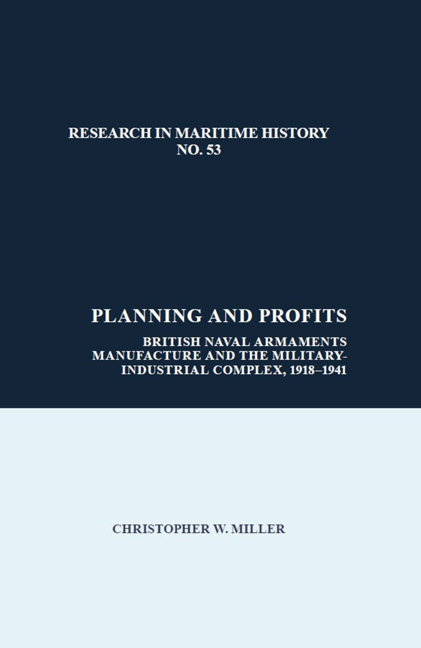 Planning and Profits
Planning and Profits Book contents
- Frontmatter
- Contents
- Acknowledgements
- About the Author
- List of Tables and Figures
- List of Illustrations
- List of Abbreviations
- A Note on Definitions
- Part One Introduction
- Part Two Industry and the Navy before Manchuria, and the Establishment of the Warshipbuilders’ Committee, 1919–1931
- 3 From Boom to Bust: The Private Naval Arms Industry and the Admiralty, 1919–1926
- 4 From Competition to Collaboration: The Warshipbuilders’ Committee and the National Shipbuilders’ Security Scheme, 1926–1931
- Part Three The Formation of a National Government, the Far East, and the PSOC Approach to Industry, 1931–1934
- Part Four The Ultimate Potential Enemy and Rearmament Planning, 1934–1936
- Part Five The Inskip Era and War, 1936–1941
- Conclusion and Retrospective
- Appendices
- Bibliography
- Index
3 - From Boom to Bust: The Private Naval Arms Industry and the Admiralty, 1919–1926
from Part Two - Industry and the Navy before Manchuria, and the Establishment of the Warshipbuilders’ Committee, 1919–1931
- Frontmatter
- Contents
- Acknowledgements
- About the Author
- List of Tables and Figures
- List of Illustrations
- List of Abbreviations
- A Note on Definitions
- Part One Introduction
- Part Two Industry and the Navy before Manchuria, and the Establishment of the Warshipbuilders’ Committee, 1919–1931
- 3 From Boom to Bust: The Private Naval Arms Industry and the Admiralty, 1919–1926
- 4 From Competition to Collaboration: The Warshipbuilders’ Committee and the National Shipbuilders’ Security Scheme, 1926–1931
- Part Three The Formation of a National Government, the Far East, and the PSOC Approach to Industry, 1931–1934
- Part Four The Ultimate Potential Enemy and Rearmament Planning, 1934–1936
- Part Five The Inskip Era and War, 1936–1941
- Conclusion and Retrospective
- Appendices
- Bibliography
- Index
Summary
The 1920s began for industry with a wave of optimism about the future for global trade and a construction boom as markets reopened and ships of all kinds lost to the war were replaced. The Admiralty also had reason to be optimistic: Britain still possessed the world's largest navy, it was preparing to celebrate the launch of its new flagship and largest ever vessel, HMS Hood, and had awarded a small – but significant – number of new construction contracts to private yards, including four for new large battlecruisers. This naval work, coupled with the boom in merchant and passenger construction, amply filled the gap left by the conclusion of emergency wartime programmes. Indeed, even in the absence of wartime orders, the naval arms manufacturers managed near-record levels of profit, output and employment into the second half of 1921. This prosperity, however, was short lived. Thereafter, the outlook changed dramatically. For industry, the increase in global trade failed to live up to the wildly optimistic forecasts, leading to significant supply overcapacity in the merchant marine and the subsequent drying up of further ship orders. For the Admiralty, the Treasury's will to cut costs was forcefully imposed upon it: the desire for a tightening of the government purse strings led to international agreements towards arms limitation which abruptly cancelled even the modest naval replacement work in hand.
Part Two of this book examines the relative fortunes of the British naval arms industry and the Admiralty from 1920 until the formation of the National Government and the Japanese invasion of Manchuria in the second half of 1931. The overriding theme is of decline: shrinking financial resources brought about by war debts and the disastrous return to the Gold Standard led to strict controls on expenditures and exacerbated the declining health of the private naval arms industry. The core argument is that the main developments in the relationship between, and relative status of, the Admiralty and industry in this period can be viewed to a large degree as a series of responses to crises, either the Treasury's financial controls or the collapse of global trade.
- Type
- Chapter
- Information
- Planning and ProfitsBritish Naval Armaments Manufacture and the Military-Industrial Complex, 1918–1941, pp. 27 - 46Publisher: Liverpool University PressPrint publication year: 2018


